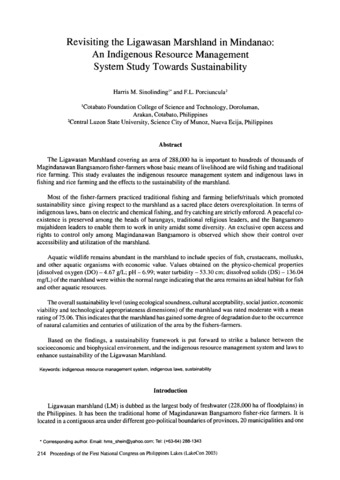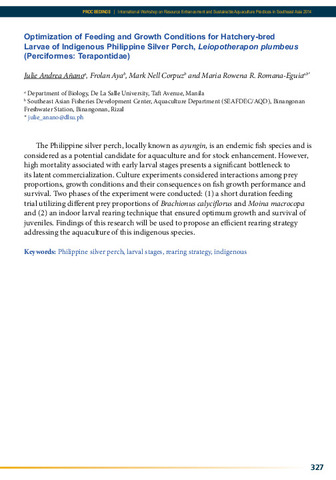Revisiting the Ligawasan marshland in Mindanao: An indigenous resource management system study towards sustainability
- Global styles
- MLA
- Vancouver
- Elsevier - Harvard
- APA
- Help
Share
นามธรรม
The Ligawasan Marshland covering an area of 288,000 ha is important to hundreds of thousands of Magindanawan Bangsamoro fisher-farmers whose basic means of livelihood are wild fishing and traditional rice farming. This study evaluates the indigenous resource management system and indigenous laws in fishing and rice farming and the effects to the sustainability of the marshland.
Most of the fisher-farmers practiced traditional fishing and farming beliefs/rituals which promoted sustainability since giving respect to the marshland as a sacred place deters overexploitation. In terms of indigenous laws, bans on electric and chemical fishing, and fry catching are strictly enforced. A peaceful coexistence is preserved among the heads of barangays, traditional religious leaders, and the Bangsamoro mujahideen leaders to enable them to work in unity amidst some diversity. An exclusive open access and rights to control only among Magindanawan Bangsamoro is observed which show their control over accessibility and utilization of the marshland.
Aquatic wildlife remains abundant in the marshland to include species of fish, crustaceans, mollusks, and other aquatic organisms with economic value. Values obtained on the physico-chemical properties [dissolved oxygen (DO) - 4.67 g/L; pH - 6.99; water turbidity - 53.30 cm; dissolved solids (DS) - 136.04 mg/L) of the marshland were within the normal range indicating that the area remains an ideal habitat for fish and other aquatic resources.
The overall sustainability level (using ecological soundness, cultural acceptability, social justice, economic viability and technological appropriateness dimensions) of the marshland was rated moderate with a mean rating of 75.06. This indicates that the marshland has gained some degree of degradation due to the occurrence of natural calamities and centuries of utilization of the area by the fishers-farmers.
Based on the findings, a sustainability framework is put forward to strike a balance between the socioeconomic and biophysical environment, and the indigenous resource management system and laws to enhance sustainability of the Ligawasan Marshland.
การอ้างอิง
Sinolinding, H. M., & Porciuncula, F. L. (2005). Revisiting the Ligawasan marshland in Mindanao: An indigenous resource management system study towards sustainability. In M. L. Cuvin-Aralar, R. S. Punongbayan, A. Santos-Borja, L. V. Castillo, E. V. Manalili, & M. M. Mendoza (Eds.), Proceedings of the First National Congress on Philippine Lakes (pp. 214-229). Southeast Asian Regional Center for Graduate Study and Research in Agriculture (SEARCA).
Type
Conference paperISSN
1656-8099คอลเลกชัน
- LakeCon2003 [49]
Related items
Showing items related by title, author, creator and subject.
-
Optimization of feeding and growth conditions for hatchery-bred larvae of indigenous Philippine silver perch, Leiopotherapon plumbeus (Perciformes: Terapontidae)
Añano, Julie Andrea; Aya, Frolan ; Corpuz, Mark Nell; Romana-Eguia, Maria Rowena R.
; Corpuz, Mark Nell; Romana-Eguia, Maria Rowena R.  (Aquaculture Department, Southeast Asian Fisheries Development Center, 2015)
The Philippine silver perch, locally known as ayungin, is an endemic fish species and is considered as a potential candidate for aquaculture and for stock enhancement. However, high mortality associated with early larval ...
(Aquaculture Department, Southeast Asian Fisheries Development Center, 2015)
The Philippine silver perch, locally known as ayungin, is an endemic fish species and is considered as a potential candidate for aquaculture and for stock enhancement. However, high mortality associated with early larval ... -
Bridging traditional knowledge with mainstream technology to sustain cultural and biological diversity in the product development of wild honey: Focus on the indigenous peoples of the Palawan Biosphere Reserve, Philippines
Declared a Man and Biosphere Reserve in 1991, the Palawan Biosphere Reserve in the Philippines is a biologically diverse province and home to a number of Indigenous Peoples particularly the Pala’wan, Tagbanua and Batak ... -
Screening of inexpensive and indigeneous ingredients for use in practical feed for juvile sea bass (Lates calcarifer Bloch)
Coloso, Relicardo M.; Hipolito, Jose Roy; Murillo, Deograce (Aquaculture Department, Southeast Asian Fisheries Development Center, 1996)An eight-week feeding experiment with juvenile sea bass (about 15 g) was conducted in 500-1 fiberglass tanks to screen the most cost-effective practical diet for use in ponds and floating cages. Eleven formulations and one ...





